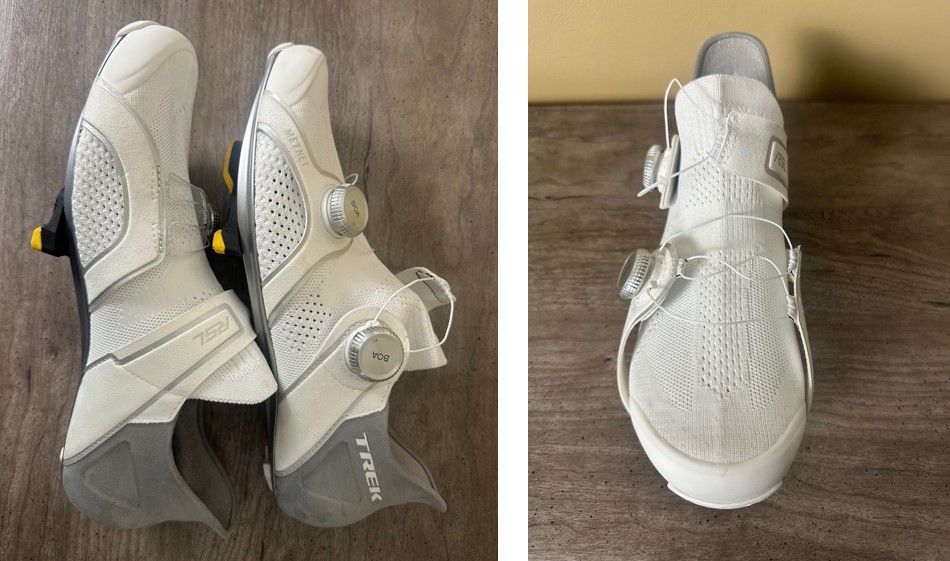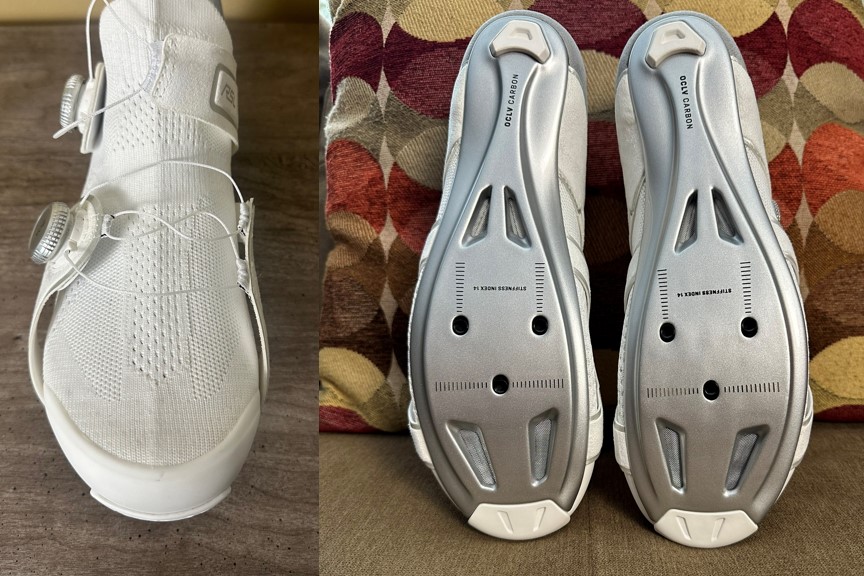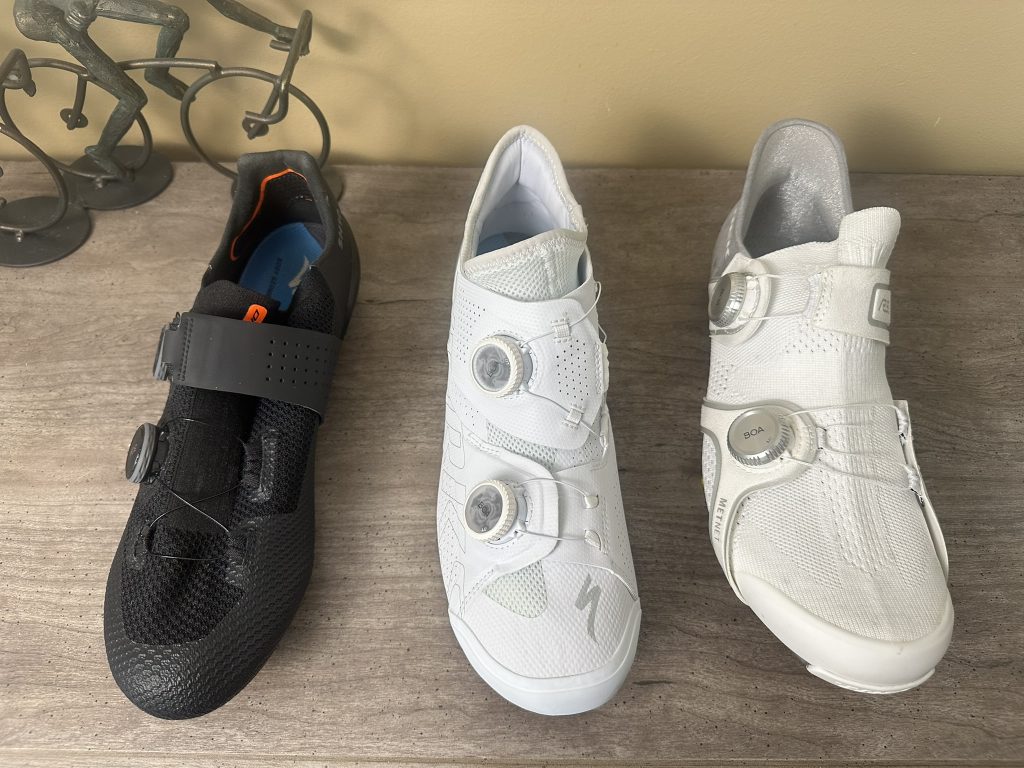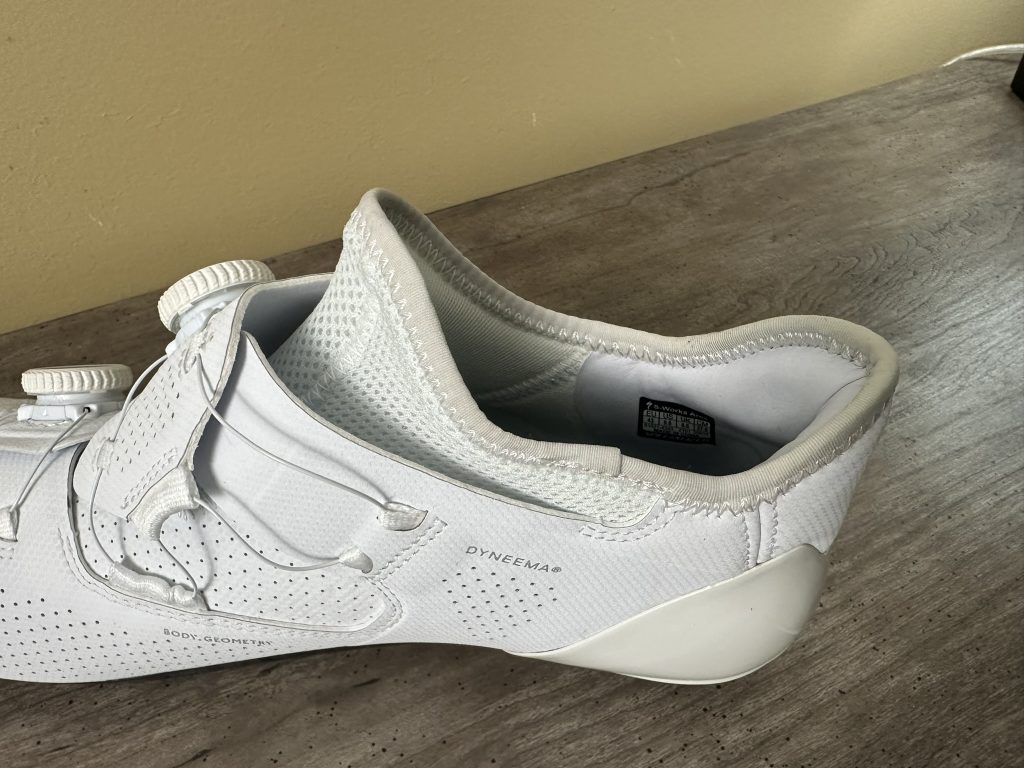TREK RSL KNIT– ALMOST ALL YOU COULD ASK FOR

The Trek RSL Knit delivers some of the best power transfer, fit, and comfort I’ve experienced in a road bike shoe. They do this in an integrated way that non-knit shoes and even current knit ones can’t match.
With the proper aftermarket insole, I really feel the difference in how these shoes help me ride even better, faster, and longer than my other top-ranked shoes.
Trek’s take on knit road bike shoes stands apart in fashion and function from other knit or knit-looking ones. They look and feel quite special and expensive, and they are both.
If the white Trek RSL Knit pair I tested didn’t take so much attention to keep clean and their multi-season durability wasn’t an open question, I’d willingly spend the US$500, £400, €450 King’s ransom they command. They’d be my first choice whenever it’s dry and above 50F/10C outside.
They’re just that good.
As it is, I can almost justify buying and saving them for those beautiful, long, demanding spring and summer days in the saddle when I want to ride my best kit.
ALL TOGETHER NOW
Nearly every two-dial, performance-level road shoe these days has a stiff outsole. The Trek RSL Knit is no different.
Yet, power transfer is also about how efficiently the shoes move with your feet and that stiff outsole to get the power from your legs into the pedals throughout your pedal stroke. And the better your feet fit in the shoes, the better they’ll move with them.
In the pair I tested, the Trek RSL Knit combined a heel cup that seemed tailored to the shape of my heel from top to bottom.
The balls of my feet were comfortably held in place by a stretchy mesh fabric Trek calls METNET, which is a wonky name for metatarsal netting.
And then there’s the knit upper, which extends from the toes to halfway up the front of your ankle area. It fits like a support sock from your forefoot back.
Narrow and thin synthetic material strips hold the BOA dials and lace guides. They attach at the shoe’s edges and rest on top of the knit when you dial in your shoe, so they don’t interfere with the support sock feeling you get from the knit upper.

The metatarsal netting (left) shapes to the balls of your feet, while the closure strips don’t interfere with the knit’s support sock feel.
Together, the stiff outsole, tailored heel cup, stretchy METNET, and support sock create a sensation of a unified fit with the unique contours of my feet. That gave me a more direct relationship with my pedals than I’ve felt before.
That’s what efficient power transfer is all about.
AS COMFORTABLE AS SOCKS
The Trek RSL Knit’s sock-like feel contours the tops of my feet, eliminating any potential hot spots. They are more comfortable than most of my work and dress shoes, then again, I don’t own a US$500 pair of work or dress shoes, nor do I train in the ones I have.
At the front of the RSL knit, there’s plenty of room for my toes to move side to side and above without feeling disconnected from the wrapped feeling I get from these shoes across the rest of my feet.
A standard-sized, sturdy bumper surrounds the front of the toes and sides of the large and small ones. And there are sufficient, non-replaceable pads at the front and back of the outsole.
Of course, the upper is highly breathable with all that knit area. Combining that with two relatively large vents under your toes makes the Trek RSL Knit a summer, late spring, and early fall road when temps are 50F/10C or more. I did wear them in March when it was a few degrees below that, but my feet were too cool even with Merino wool socks.
KNOWN AND UNKNOWNS
When I first tried on the Trek RSL Knit shoes, I had two reactions: Where’s my shoe horn, and do we have any Scotchgard in the house?
Until the knit upper above my midfoot loosened up, I had to use a shoehorn to get into these Treks. After wearing them a half-dozen times, I could pull them on without one, thanks in part to what looks like a ramp to slide the bottom of your heel into the shoe.
That on-ramp is a rather ingenious solution, but the need for one got me thinking – will the knit upper continue to stretch to where the support-sock feeling turns into a worn-sock one? After three months and a few dozen times wearing them, they don’t seem to have stretched any further, but we’ll see.
While I couldn’t find any Scotchgard or another stain-repellent fabric spray, Trek assured me that the RSL Knit uppers clean up with soap and water. So far, they have, but I also haven’t taken them on any dirty rides.
Every pair of white shoes I’ve ever worn requires extra care to keep clean. Most of those with synthetic uppers will clean up from dirt pretty well, less so from scuffs. Wearing white is definitely a fashion statement. Given my choice, I’d go with the good-looking black Trek RSL Knit option.
A more functional unknown is how well the lace guides will hold up and maintain their shape over time. They’re made of pliable nylon similar to that on other knit shoes rather than a stiffer plastic used in most road cycling shoes.
When you tighten the RSL Knit’s dials, the tension on the laces roughly halves the width of the guides, reducing the space between the laces that cross the tops of your feet. While this hasn’t created any hot spots for me yet, I don’t know how well the guides will maintain the position of the laces after a season or two of tightening and loosening.
Like most cycling shoes, the insoles included with the Trek RSL Knit don’t provide enough arch support for my feet. Shoes from Shimano, Northwave, and some others come with multiple arch wedges or insole options, but these Treks don’t. For the price the RSL Knit sells for, they should.
A KNIT ABOVE
Before reviewing the Trek RSL Knit shoes, I’d previously worn or tested the knit or knit-like DMT SH10, Specialized S-Works Ares, and Rapha Pro Team road shoes.
The DMT and Specialized shoes have a lot of knit material in the uppers, but they depend a good deal more on other materials for the shoe’s function.
DMT uses a durable coating on the outside of the lower half of its knit upper to protect the shoe. There’s also a closed-cell liner material on most of the inside of the upper. The only place where the knit is both uncoated and unlined is above your middle three toes.
The Specialized S-Works Ares has more knit area than the DMT SH10 but covers about 2/3rds of the knit with sturdy flaps that support its dials, laces, and guides. The dials are also closer to the centers of your feet than most road bike shoes I’ve tested or seen.
The Ares has a pretty heavy seam that’s uncomfortable to rub against around the opening and down through the knit area.
While both shoes have ample toe box room, they are snug across the forefoot, and there’s no knit or mesh to provide any give to the inside or outside balls of my feet. While I like a snug fit, these two models run narrower than most in the forefoot.
The Rapha Pro Team is a great-performing, stylish, knit-looking shoe that actually uses a woven polyester upper material instead.
Compared to the Trek RSL Knit, none of these shoes fully takes advantage of having a knit upper or integrates it into the design the way the Trek shoes do. The knit’s primary purpose seems to be for ventilation and appeal.
Indeed, the DMT and Specialized shoes seem to compensate for their use of the knit material by coating, lining, or covering a large portion of it.
Trek appears to have learned that knit shoes are not just about offering better-ventilated shoes but also improving power transfer and comfort.
You can buy the Trek RSL Knit road cycling shoes using these links to Trek and Sigma Sports.
In The Know Cycling is ad-free, subscription-free, and reader-supported. If you want to help keep it rolling without any added cost to you, buy your gear and kit after clicking the store links on the site. When you do, we may earn an affiliate commission that will help me cover the expenses to create and publish our independent, comprehensive, and comparative reviews. Thank you, Steve. Learn more.
In my review of the best road cycling shoes, you can compare our reviews and ratings of these shoes and competitively performing models.




I am glad you mentioned the Specialized Ares, which I think was the first “knit” shoe, and has been owned by me since March of 2021. The Ares, when first released, had similar comments like requiring a shoehorn and possessing good power transfer. But I am wary of this design because, at least in my case, the Ares knit section has badly ripped during my 3 years of use, probably beginning after one year. I suspect the the two flaps that cinch down on the knit fabric caused some pressure points and friction that, over time, led to abrasion and damage to the fabric. The Trek RSL Knit appears to have a smoother, more forgiving design in this regard, so maybe they will hold up better over time. I wish I could supply a photo to show just how bad the rips are. The shoes are still in use until I decide on a suitable replacement, but every time I put them on I feel some disappointment and regret.
You would recommend not getting the treks then? I have conserves about longevity
Hello are true to size. My size is sold out they have 0.5 smaller would you think sizing down half a size would work out?
Thabks
The RSL Knit in my normal size was too large. I went down a half size and they fit me. They’re well built and have held up well for me but knit shoes and white knit shoes especially will not likely last as long or stay as white as darker knit shoes or darker shoes with a synthetic upper.